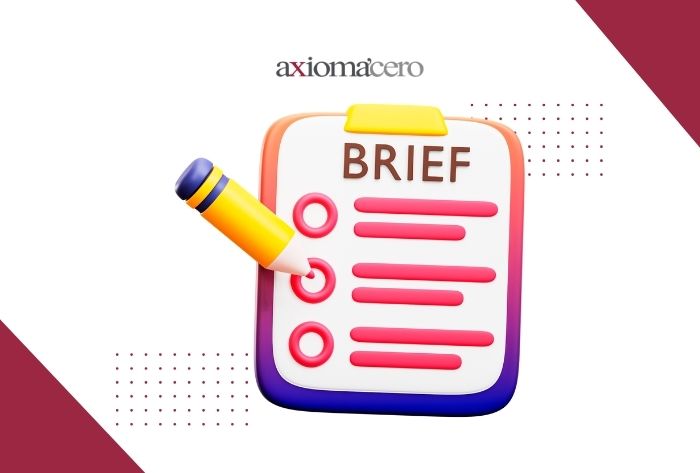Design Brief: What It Is, How to Create One, Examples

In graphic design and digital marketing, the design brief is a fundamental tool. A well-crafted brief can make the difference between a successful project and one that falls short of expectations.
In this article, we will explore in detail what a design brief is, how to create an effective one, and present practical examples to help you improve your digital marketing and graphic design strategies.
What is a Design Brief?
A design brief is a document that contains all the necessary information for a designer or a team to clearly understand the objectives, scope, and expectations of a project. In other words, it is the guide that directs the creative process and ensures that everyone is aligned with the client’s goals.
Importance of the Brief in Design
The brief is essential because it provides:
- Clarity and Direction: It offers a clear vision of the project and sets expectations from the beginning.
- Time Savings: It prevents misunderstandings and rework, saving time and resources.
- Efficiency: It facilitates the planning and execution of the project, ensuring that all involved are working in the same direction.
How to Create an Effective Design Brief
Key Elements of a Brief
To create an effective brief, it is important to include the following elements:
- Project Objectives Clearly define what the project aims to achieve. Is it an increase in sales, a better brand perception, or higher social media engagement?
- Target Audience Describe who the target audience is. What are their demographic characteristics, interests, and behaviors?
- Key Message What is the main message you want to convey? This should be clear and concise.
- Tone and Style Specify the tone and style of the design. Should it be formal, informal, fun, serious?
- Deadlines and Deliverables Set deadlines for each phase of the project and define the expected deliverables.
Tips for Writing a Design Brief
- Clear Communication Use clear and direct language. Avoid technical jargon that might confuse the client or the team.
- Collaboration Involve all stakeholders in creating the brief to ensure that all expectations and needs are considered.
- Flexibility While it’s important to be specific, it’s also crucial to leave room for creativity and necessary adjustments throughout the project.
Examples of Successful Briefs
Case 1: Website Redesign
- Objective: Modernize the website design to improve user experience and increase lead conversion.
- Target Audience: Digital marketing professionals, project managers, and entrepreneurs.
- Key Message: “A modern and efficient platform to boost your business.”
- Tone and Style: Professional, clean, and modern.
- Deadlines and Deliverables:
- Research and Wireframes: 2 weeks
- Visual Design: 4 weeks
- Development and Testing: 6 weeks
Case 2: Social Media Campaign
- Objective: Increase social media engagement and drive more traffic to the website.
- Target Audience: Young adults aged 18-34, interested in technology and lifestyle.
- Key Message: “Discover the latest in technology with us.”
- Tone and Style: Informal, friendly, and approachable.
- Deadlines and Deliverables:
- Content Planning: 1 week
- Content Creation: 2 weeks
- Publishing and Monitoring: 4 weeks
Practical Tips for Integrating the Brief into Graphic Design
- Know Your Client Understanding the client’s needs and expectations is crucial. This can be achieved through detailed meetings and interviews.
- Research the Target Audience Conduct thorough research to understand who your audience is and what motivates them. This will help design something that truly resonates with them.
- Define a Clear Message Ensure that the key message is clearly defined and consistent throughout the design.
- Use the Appropriate Tone The design’s tone should align with the brand and the target audience. A design that feels “off-brand” can confuse users and dilute the message’s impact.
- Iterate and Seek Feedback Don’t be afraid to make several iterations of the design and seek continuous feedback from the client and the target audience.
Frequently Asked Questions
- Why is a brief important in graphic design? A brief is important because it provides a clear and concise guide on the project’s objectives, ensuring that all involved are aligned and working towards the same goal.
- What happens if a brief is not followed? If a brief is not followed, it can result in misunderstandings, rework, and ultimately a project that does not meet the client’s expectations.
- How can I ensure my brief is effective? To ensure an effective brief, involve all stakeholders, clearly communicate the objectives and expectations, and leave room for flexibility and creativity.
A well-crafted design brief is essential for the success of any graphic design project. It not only provides clarity and direction but also ensures that everyone involved is aligned with the client’s goals. By following the tips and examples presented in this article, you can create effective briefs that will significantly improve your digital marketing and graphic design strategies.
For more information and useful resources on how to improve your digital marketing and graphic design strategies, visit our website https://www.axiomacero.com. Don’t forget to follow us on our social media for more tips and updates on the world of digital marketing.